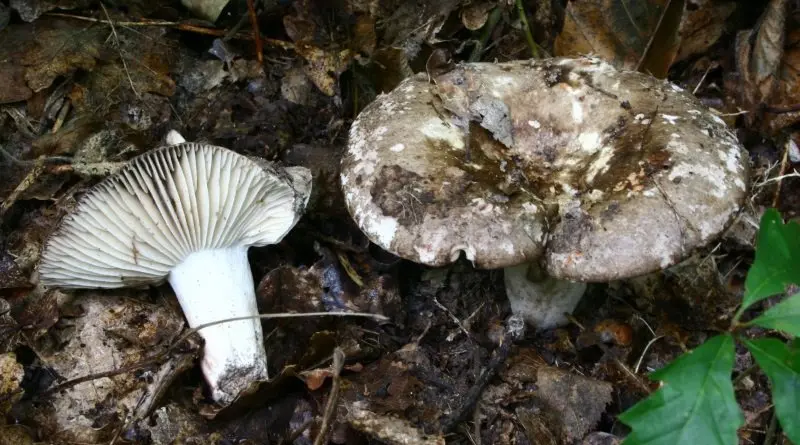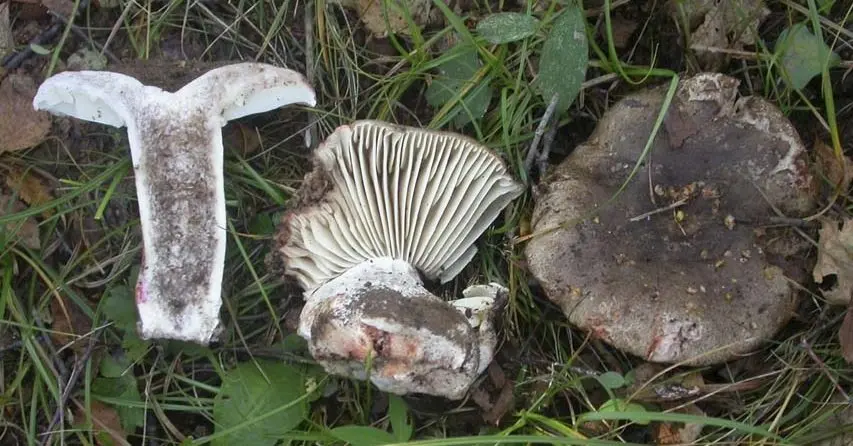Blackening podgrudok (Russula nigricans)
- Division: Basidiomycota (Basidiomycetes)
- Subdivision: Agaricomycotina (Agaricomycetes)
- Class: Agaricomycetes (Agaricomycetes)
- Subclass: Incertae sedis (of uncertain position)
- Order: Russulales (Russulovye)
- Family: Russulaceae (Russula)
- Genus: Russula (Russula)
- Type: Russula nigricans (Blackening load)
- Russula blackening

Blackening podgruzdok – a type of fungus is included in the genus Russula, belongs to the russula family.
It has a hat from 5 to 15 centimeters (sometimes there are larger specimens – even up to 25 centimeters in diameter). At first, the hat has a whitish color, but then it becomes dirty grayish, brown with a hint of soot color. There are also brownish specimens with an olive tint. The middle of the cap is darker, and its edges are lighter. On the hat there are adhering particles of dirt, earth, forest debris.
The blackening load has a smooth cap, dry (sometimes with a slight admixture of mucus). It is usually convex, but then becomes flat and prostrate. Its center becomes smooth over time. The cap may develop cracks that expose the beautiful white flesh.
The plates of the fungus are thick, large, rarely located. At first they are white, and then gray or even become brownish, with a pinkish tint. There are also atypical ones – black plates.
Leg Loading blackening – up to 10 centimeters. It is strong and cylindrical. As the fungus ages, it becomes a dirty brown color.
The pulp of the mushroom is thick, breaking. Usually – white, at the site of the incision slowly becomes reddish. It has a pleasant taste, slightly bitter, and a pleasant faint aroma. Ferrous sulfate turns such flesh pink (then it turns green).
Distribution area, growing time
The blackening podgruzdok forms a mycelium with hard tree species. Grows in deciduous, mixed forests. Also, the mushroom can often be seen in spruce and deciduous forests. The favorite place of distribution is the temperate zone, as well as the region of Western Siberia. The fungus is not rare in Western Europe either.
Found in large groups in the forest. It begins to bear fruit from mid-summer, and this period ends until winter. According to the observations of mushroom pickers, it is found in such a northern region as the Karelian Isthmus, at the end of the forest it is not uncommon in the territory of the Leningrad Region.

Mushroom lookalikes
- White-black podgruzdok (Russula albonigra). He has thick and flowing plates, as well as a whitish hat, a grayish tint. The pulp of such a fungus can turn black almost immediately. Redness in such mushrooms is not visible. In autumn, in birch and aspen forests, it is quite rare.
- The loader is often lamellar (Russula densifolia). It is distinguished by a brownish-brown and even brown hat with a black tint. The plates of such a hat are very small, and the mushroom itself is smaller. The flesh at first becomes reddish, but then slowly turns black. In autumn, it is quite rare in coniferous and mixed forests.
- The loader is black. When broken or cut, the flesh of this fungus turns brown. But it has almost no dark, almost black shades. This mushroom is an inhabitant of coniferous forests.
These types of fungus, as well as Blackening Podgrudok itself, form a separate group of fungi. They differ from others in that their flesh acquires a characteristic black color. The old mushrooms of this group are quite tough, and some of them can have both white and brown shades.
Is this mushroom edible
Blackening podgruzdok belongs to the mushrooms of the fourth category. It can be consumed fresh (after being thoroughly boiled for at least 20 minutes), as well as salted. When salted, it quickly acquires a black tint. You need to collect only young mushrooms, as the old ones are quite tough. In addition, they are almost always wormy. However, Western researchers consider this mushroom to be inedible.
Video about blackening blackening mushroom:
additional information
The fungus can grow in the substrate. Some old specimens of the fungus can come to the surface, this breaks through the soil layer. The fungus can often be wormy. Another characteristic feature of the fungus is that it slowly decomposes in natural conditions. During decomposition, the fungus turns black. Dried mushrooms are stored for quite a long time, until the next year.









